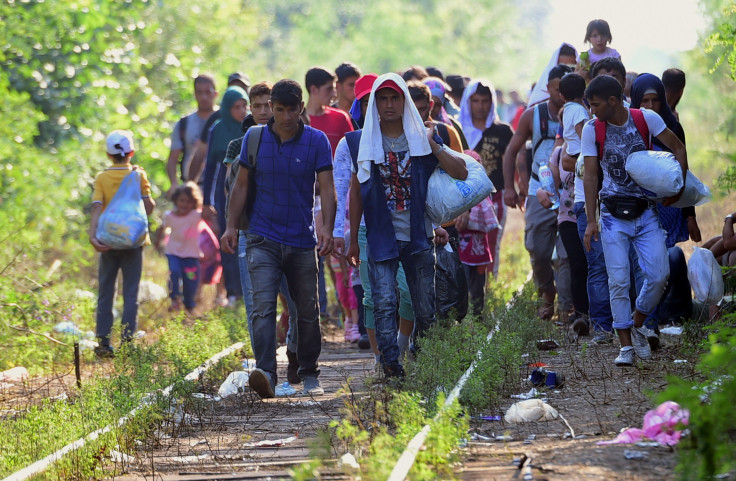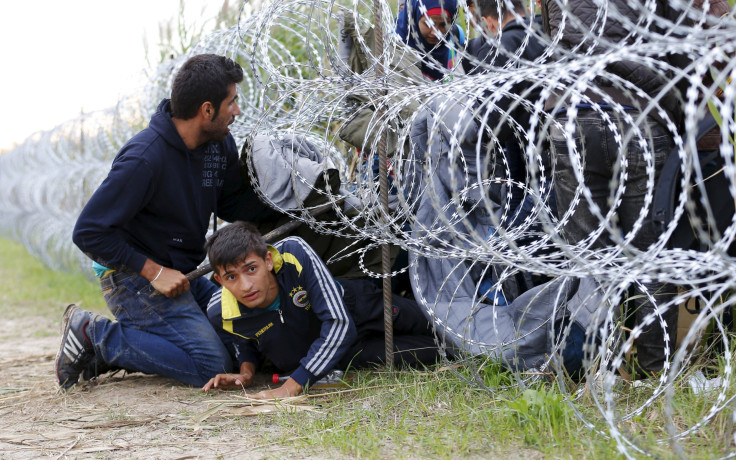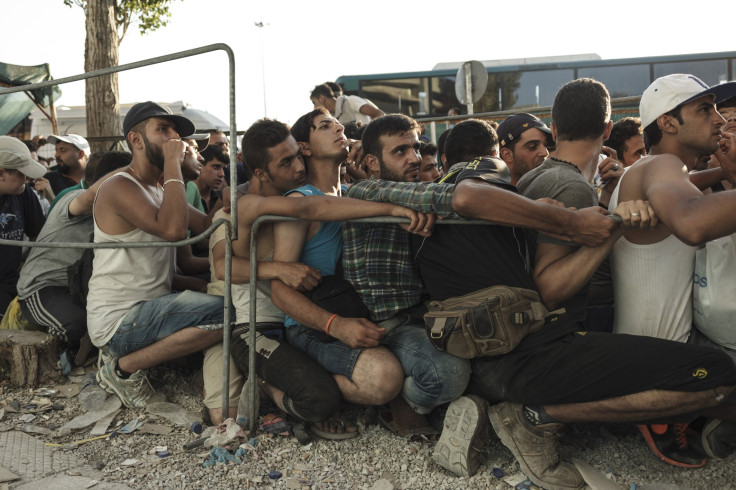EU Migrant Crisis 2015: Walls And Fences Fail To Stem Migration As Austrian Lorry Deaths Reveal The Dangers Of Smuggling

When 71 people, including eight women and three children, were found dead from asphyxiation Thursday in an abandoned truck outside Vienna, it served as the latest example of the increasingly desperate attempts migrants are making to enter Europe in hopes of achieving a better life for themselves and their families. The groups of migrants and refugees, mostly composed of people from North Africa and parts of the Middle East, have crossed borders by clinging to the bottoms of trucks, sailing on rubber dinghies across the Aegean Sea, and paying hundreds of euros to be smuggled in cars and other vehicles.
Tightening borders, in part by building fences and walls, has not deterred migrants from trying to enter the European Union, and people have been arriving by the thousands since January. Ironically, walls and fences have often had the opposite of their intended effects, migration experts say. As migrants see the gates to Europe steadily closing, their attempts to enter have only become more frequent and more desperate, as they resort to traveling dangerous routes and relying on professional smugglers.
“They might hear about borders going up, but they see a conflict-free continent,” said Sanj Srikanthan, policy director for the International Rescue Committee, a worldwide humanitarian nonprofit that works with refugees in Europe.
More than 340,000 people have entered Europe since January, with 105,000 entering in July alone, making 2015 a record-breaking year. As conflicts in the Middle East and North Africa -- particularly in Syria and Sudan -- continue to escalate, people have flowed out of those regions by the thousands.

In response to the influx, many European nations have increased border security, with Hungary working to finish a wall along its Serbian border by the end of the month and France reinforcing a fence around the Eurotunnel entrance that marks its border with Britain.
'More Hazardous Journeys'
Many of those arriving at EU borders have already faced greater dangers of sectarian violence and terrorism in their home countries, including a war in Syria that has claimed at least 220,000 lives, Srikanthan noted. “They are making far more hazardous journeys than crossing a Hungarian wall or a tunnel at Calais,” he said.
“The biggest and most notable effect [of fences] is simply changing migration routes,” said Susan Fratzke, an analyst at the Migration Policy Institute, a Washington, D.C., think tank that studies migration trends. Despite fences built in Turkey, Spain and Hungary in recent months, the number of arrivals hasn't subsided. “It’s forcing people to take a route that they otherwise wouldn’t use because of the dangers,” Fratzke said.

Migrants have often turned to smugglers when fences and other obstacles have blocked their path. Authorities speculated that the people who died in the abandoned truck in Austria were likely crossing the border with someone who had been paid to transport them. Migrants typically pay 50 to 100 euros ($56 to $112) for passage in a cramped vehicle across a border, and some have paid as much as 2,000 euros ($2,240).
The use of human smugglers has been on the rise across Europe, notably on the border between France and Italy and at the Eurotunnel entrance between France and Britain. Because smuggling is a clandestine crime, authorities do not have a clear picture of who is organizing the border passages and how many people have participated. Authorities in France and in the Balkans region have said that the majority of people stopped with migrants in their vehicles are local citizens looking to make some quick cash. A handful of the smugglers, however, are working for organized-crime rings, said Francois-Xavier Lauch, a press agent for a French municipality near the Italian border, in an interview earlier this month.
“Smugglers and traffickers tend to be one step ahead of authorities,” said Sian Jones, a researcher in the Balkans for Amnesty International. Smuggling is extremely dangerous, often resulting in death, and because it is a transnational crime, it's often hard to track and prosecute.
Migrants spend a large chunk of their savings to travel the distance of a few kilometers in a cramped vehicle, without any guarantees of a better life in Europe. The vast majority of refugees who reach their final destination -- whether it's Germany, Britain or Finland -- have no legal status. The best possible outcome for most refugees would be to find a job and get paid a minimum wage, or five to 15 euros hourly, under the table. It may not be the dream of Western prosperity, but for people fleeing sectarian violence in places like Syria, it's worth the gamble.

Physical obstructions had a similar effect on migration to the United States from Mexico, where a 700-mile fence has done little to stop people from coming -- and seemingly encouraged further smuggling. "More than nine out of 10 who come to the border succeed eventually in gaining entry," an article in an English-language Mexican newspaper reported. "Fences can always be climbed over, dug under, or gone around," the article said.
Pit-Stop Countries
For most migrants in Europe, countries such as Hungary, Greece and Italy are only meant to be a pit stop, the closest point of entry from North Africa or the Middle East on the path toward northern European countries with stronger economies and more plentiful opportunities. The borders of these first entry-point countries have been the most chaotic, with huge lines as migrants wait to be documented before they can continue to their ultimate destination.
Europe has not seen this many refugees since World War II and was caught completely unprepared for the surge in arrivals. Many temporary shelters in Greece, Italy and the Balkans region do not have enough food or water. The refugee camps are largely overcrowded and tensions between migrants and Europeans have continued to grow as authorities debate what should be done to address the crisis.
Politicians, particularly from right-wing political parties, have continued to advocate for fences and border control, despite mounting evidence that fences do not serve as a major deterrent. “[There is] a political appetite to be seen to be doing something about this,” Srikanthan said, adding that a wall was a one of the most visible ways for governments to show citizens that they were making an effort to stem the flow.
“The ministers of the interior feel that the whole of Africa will come to the EU,” said Katerina Kratzmann, director of Austria’s bureau of the International Organization for Migration, an intergovernmental organization that works to assist in refugee situations. “There’s so much panic, and there’s so much crisis that then people tend to think very much in short terms, not in long-term solutions,” she said Thursday.

A more symbolic effect of the fences and walls, many aid workers say, is to send the message that these migrants are an invading population, not refugees fleeing war. The United Nations estimated that 85 to 90 percent of those arriving in the EU in recent months are bonafide refugees, defined as people who left their countries due to persecution and violence.
As refugees, these people should be afforded the dignity and respect that the label confers, including safe passage to the nation where they are trying to seek asylum, Kratzmann said. “We’re pretty far away from that if we have dead bodies in a lorry,” she said.
'Tragic Indictment'
Nonprofits and European authorities alike have begun discussing new policy suggestions, such as an EU-wide reception center for refugees, while they wait for paperwork to be processed, or an EU refugee council that would be responsible for ensuring that applications for asylum were processed rapidly.

Most experts agree that any sustainable solution would need to involve all EU member states sharing the burden of migrant care and would likely require each nation to agree to take several refugees.
“People dying in their dozens -- whether crammed into a truck or a ship -- en route to seek safety or better lives is a tragic indictment of Europe’s failures to provide alternative routes," said Gauri van Gulik, Amnesty International's deputy director for Europe. “Europe has to step up and provide protection to more people, share responsibility better and show solidarity to other countries and to those most in need.”
© Copyright IBTimes 2024. All rights reserved.






















